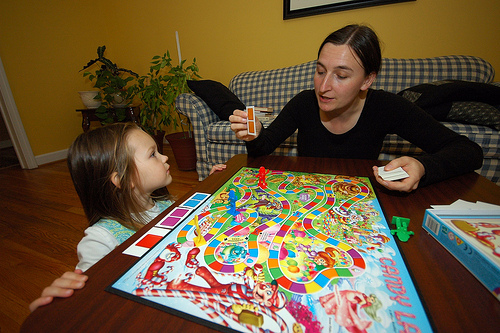Exponent
Projects have a way of growing on me. I imagine a particular project taking a given amount of time, effort, and resources, and it never turns out that way.
“I’m going to use the orbital brush cleaner to get the kitchen floor sparkling and then put a couple of coats of protective finish on it,” I say before a day off. “It shouldn’t take me more than three hours.” In reality, I’m off by 66%: it takes me five hours.
“I’m going to replace the front sillcock. It shouldn’t take more than a couple of hours, maximum.” Lunch time comes and I’m still wrestling with it.
I look into the future at projects K and I hope to complete: remodel rebuild the kitchen; remodel the master bathroom; landscape the back yard. These are not minor endeavors. These are things that I anticipate taking weeks, which means they will take months.
The problem is, once I get started, I don’t want to cut corners. At least that’s what I tell myself: I end up doing that anyway, but it makes me grit my teeth to think about it, and I know there’s more to the extended projects than my perfectionism.
It all comes down to inexperience. Except for plumbing, no project intimidates me, but I know my lack of experience will make the job three times as long as it should require. Experience has taught me that, for I used to think my home improvement inexperience would double the time.
Our living room is turning into one such project. “We’ll just pull out the furniture, repaint the walls, polish the floor, and put the new furniture back in.” If only it were that simple.
Saturday the Chameleon
Another Saturday completed: we repainted the living room in preparation for a complete redecoration.
First and second coats and we’re pretty much done. I admit I’ll miss the yellow.
K felt it was too bright; I loved the way it made the room open.
Between coats, I mowed and raked some leaves. It was not warm enough to break a sweat, and so it almost didn’t even feel like work. But by most definitions, it was.
In another life, twenty-five to thirty years ago, my Saturdays were supposed to be days of reverence and quiet rest. Saturday is, of course, the seventh day; Jews and a few groups of Christians believe it is the sabbath, a time of rest. There’s something appealing about that to me, even today.
Still, in the intervening years, my associations with and expectations of a good Saturday have literally turned 180 degrees. Just as I couldn’t imagine mowing then, I can’t imagine not spending Saturdays working now.
It makes me wonder what else might flip-flop in my life, and what else has changed without me yet truly noticing.
Fourth Thursday
With a three-year old and no travel plans for Thanksgiving, we planned dinner around her nap. That gave us the whole morning to work around the house. As L grows, she’s increasingly eager to help.
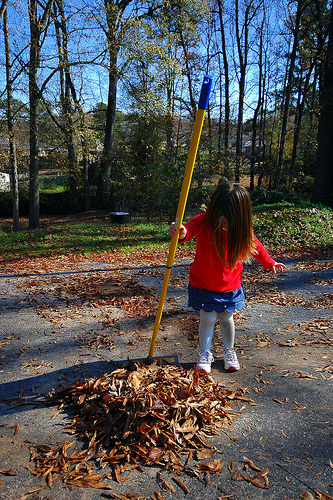
It’s impossible to put beans into the coffee grinder or tea into the infuser without L calling, “I want to do it! I want to help!” When I stir something in the sauce pan, when K sweeps the kitchen, L is there, ready to help.
Indeed, if we don’t let her help (either intentionally or accidentally), it sometimes leads to a mini-meltdown.

When we arrived at Nana and Papa’s for turkey and the fixings, they had a surprise for L.
“We’re tired of making a tent for her,” Nana explained earlier in the week when I dropped by. It was, I would imagine, a well-established ritual: ottomans pushed together, with a blanket spread over it to create a small space for L to wallow in.

As planned, it kept the Girl busy while everyone helped out with the final stages of dinner.

Turkey with dressing and giblet gravy, with sides of rice, casserole, and cranberry sauce. What could be more American? Indeed, as I ate dinner, I remembered when, living with a host family in Poland, I was asked to create a typical American meal. I mentioned the Thanksgiving feast; I was relieved when told (this was 1996) that getting a whole turkey would be, at best, difficult.

After dinner was play time (until the turkey overwhelmed Papa and he began his post-dinner, in-seat nap).

It was the first Thanksgiving without any extended family at all. No traveling; no sleeping in strange beds; no absolute dread if it was a rainy day in South Carolina, requiring us all to stay inside with four generations of smokers. It was Thanksgiving without any of the negatives. It also lacked some of the positives that certainly accompany large family gatherings.

Yet, for one of the first Thanksgivings L will probably remember (at least for a few years), it was perfect. Especially the Mlenmorangie Papa brought out after dinner.
Rings
As a kid, I used to wonder what the view of the heavens would look like if we had some characteristics of other planets in our solar system. I would imagine multiple moons in the sky and vaguely wonder about the effects they would have on the earth.
Learning about dual stars and watching 2010, I wondered what the earth would be like with two suns. “Two suns in the sunset” Roger Waters sang on The Final Cut, the last album he recorded with Pink Floyd, but he was referring to the prospect of nuclear war.
For some reason, though, it never occurred to me that the earth could have rings. Apparently, it’s occurred to others:
https://www.youtube.com/watch?v=SNCBh2MLvdw
Stacking the Deck
A daily game of Candy Land has wiggled its way into our routine. L has mastered the concepts: she knows what the cards are for and she generally knows which direction her piece needs to move.
The problem is that Candy Land is unimaginably dull: draw a card, move your piece, wait. Repeat. While L was learning, it was a pleasant game: actually playing the game was not the objective, and as I love teaching, any educational activity is enjoyable.
Now that she knows how to play the game, though, it can drag.
I feel a little guilty about that. I should adore every single moment with her, but let’s face it: there are only so many times you can feign surprise at having to go back to the Gingerbread House.
When I was working with autistic children, Candy Land was a popular free time choice. I got so utterly sick of it that I — and I am somewhat ashamed to admit it — stacked the deck to make sure the kid I was sitting opposite got all the good cards.
“What!? Another double-purple? Well, you’re well on your way, aren’t you?”
I haven’t done that with L yet. In the truest sense of “stacking the deck.” I might have switched the top two cards after a quick peek at my own, making sure she got another double-purple, but that’s not really stacking the deck. That’s helping.
Little Drummer Girl
Goals
A goal of posting daily for an entire month seems simple enough. In reality, with a three-year-old and house, I’m discovering it’s quite a trick. A day of wandering around Ikea after a night of insufficient sleep makes it seem relatively insignificant.
“What’s the big deal?” I ask. “I’ll just skip a day and then the pressure will be gone. Back to normal: three or four times a week.”
Then I think perhaps that is a post in and of itself. Part of the circular nature of posting daily on one’s own site: blogs tend to foster posts about blogging just as poetry tends to lead poets to write about the act of writing. It seems relatively insignificant and somewhat egotistical, but I don’t care. It’s almost eleven; I’ve posted for the twenty-first day in a row; I might be cheating, but then again, maybe not: I make the rules around here.
Time Machine
I work in a time machine. Each and every day, I’m transported to my middle school days as I see bits and pieces of my eighth grade year reflected by my students. Times have changed — there’s certainly a lot more hugging going on these days, for one — but the gravity-bending, end-of-the-world trials of thirteen- and fourteen-year-olds remain. Students charge up and down the hall, furious about this or that, certain it’s the end of the world. Love blooms and the infatuation they’re now experiencing is the one to see the young lovers through the rest of their natural days.
I see myself in this or that student. I see peers in his peers. I watch experiences that I had, and I wonder if they will shape the young people in the same way the events shaped me. Broken hearts, unjust accusations, careless comments — I look back on these things with calmness now, though I felt nothing but anguish then.
Occasionally this gets me to wondering about how I would handle middle school differently were I suddenly to return. Would I have been calmer? Would I have realized that this or that disaster was nothing of the sort? Certainly, but then, twenty-some years later, I’d be wondering the same thing again. “Knowing what I know now, after two times through, would I…”
Part of growing up is growing out of this kind of thinking. Yet spending seven hours a day with thirteen- and fourteen-year-olds makes it easy to wallow in the nostalgia. For about three seconds.
Policing the Waistline
Our school has a dress code that in effect creates a school uniform. It is, in short, relatively strict. Regarding shirts, it reads, in part:
- Navy, red, black, or white (solids only)
- All shirts must have a collar and sleeves
- No shirts made of 100% Lycra or Spandex
- Shirts may not have stripes on the collar or armband
- All shirt tails MUST be long enough to be tucked in at all times while on campus or field trips
The county dress code is somewhat more lenient, and on occasion, students are able to come dressed in the less restrictive, county dress code.
For all involved, it usually turns into more of a nightmare. Such esoteric concerns as “Should this shirt be tucked in?” and “Is this accessory permissible?” take up much of the first minutes of the day.
A few weeks ago, we had such a “county dress code day” and there was much emotion and worry about whether the fashionable, down-to-the-bottom-of-the-crotch tee-shirts had to be tucked in or not. County dress code states that shirts that are designed to be tucked in should be tucked in, so it was a reasonable assumption that this particular style shirt didn’t have to be tucked in. Other styles caused problems, and a general rule was implemented just before first period: if it’s a rounded seem, tuck it in.
It occurred to me that a clothing designer could create a dress shirt (i.e., with the rounded shirt tail) with the intention of it not being tucked in. And walking back to the classroom, I shook my head and laughed aloud at the amount of energy we expend on such trivial things as whether or not to tuck in a shirt.
And the experience made me quite thankful for our strict dress code. The kids complain about it and about my enforcement, but I can simply respond, “The dress code is out of my control, and I will get reprimanded if I don’t enforce it. So if you have a problem with it, you should talk to the principal.” In short, it allows me to pass the buck.
Chick on Evolution
Many Christians who criticize evolution are criticizing a caricature of evolution, presented by their preacher and not by a scientist. They don’t even understand the basics of the theory they claim to be debunking, and their efforts to disprove evolution illustrate this with painful clarity.
Recently, when I stopped for coffee, I found a Chick Tract about evolution. I knew what I would find inside, but I couldn’t help but read it out of curiosity.
It was filled with such a ridiculous presentation of evolutionary theory that I found it difficult to believe that anyone who wasn’t already convinced could be convinced through such a simplistic, silly presentation.
The most basic assumption anti-evolutionist Christians make about evolution is that it proposes a linear, step-by-step evolution from lower to higher creatures. They insist that evolution teaches that humans come from monkeys. This particular tract begins with just such a time line.




“If we come from monkeys,” creationists ask, “Why don’t we see any half-monkey, half-humans?” Indeed, if evolutionary theory supported such an idea, that would be a legitimate question. Yet any evolutionary biologist will tell you that the theory of evolution suggests no such thing. Instead, evolutionary theory postulates that primates come from a common ancestor. In other words, we had the same great9,393,393-grandparents, but our lines split somewhere along the way.
Another common tactic is to associate evolutionary theory with religion. That was the tract’s next step:

I have never heard anyone refer to evolution as his or her “religion.” Further, very few people blindly trust their professors because any professor worth his or her keep wouldn’t expect it. Further, science doesn’t work that way. Science doesn’t seek blind faith like the tract’s mother illustrates. It discourages it, in fact.
What’s most amusing, though, is the illustration the mother is holding in the second panel. With its illustration of a cave man battling a dinosaur, it is more fitting for a creationist. After all, the creationist museum in Kentucky has a diorama that includes humans with dinosaurs. (Before the fall, T-Rex used those massive teeth for breaking open coconuts, as all creatures were vegetarians before the Fall.)
In most arguments, it’s a short step from “evolution says we’re all descended from monkeys” to “that means I’m equal to god.” It’s an illogical step, because God doesn’t come into the picture with evolution. That’s the point: it’s about observable, testable, measurable data. God isn’t easy to measure or convince to come into the lab for tests. That’s why evolutionary theory is agnostic, and why intelligent design is not science: both are claims that science cannot test.
Still, creationists somehow make the connection, and Chick does a finely amusing job of illustrating this:

The answer to little Johnny’s question is, “Nothing, really.” And that’s not because there is no God and therefore Johnny can place himself on a pedestal. It’s because people willingly make gods (of other people, stones, abstract ideas) all by themselves, and with a little convincing and hocus pocus, individuals convince others to turn them into gods. Priests and televangelists do it all the time. Watch Benny Hinn’s performance: while he says he’s a conduit for the Holy Spirit, it’s clear there’s something else going on in that ego of his.
Yet this notion that evolution does away with morality is ridiculous. Most moral codes are very practical: they protect us from others “lying, cheating” and becoming mini-gods. It’s only an anything-goes situation if people are willing to live in chaos. Most people don’t care for chaos, so we curb our desires for the good of all, including ourselves. If we’re unable or unwilling to curb those desires, the state curbs them for us. (A very Hobbesian view, I realize.)
At this point, the tract takes an unexpected turn. It’s not the proselytizing that’s unexpected; it’s the theology that’s a bit odd.


This “special blood” theology is something very new to me. It sounds, quite honestly, very primitive. It suggests the notion of blood brothers: mix your blood with another person and it somehow makes you qualitatively different. It makes me think of the old notion that somehow your essence, the core of your being — be that good or evil — can be transmitted through your blood.
It also makes God quite literally a blood-thirsty being. But then again, Jack Chick’s tracts were never about creating an image of a god that any rational, compassionate person would like to have anything to do with.


Chick’s god is little more than a small child, focusing the sun’s beams on an ant, grimly smiling as the ant writhes in pain.
If I treated my daughter the way Chick’s god treats humans, I’d be very rightly locked up for child abuse.
Country Night Sky
It’s impossible to stay in rural South Carolina and not take a few night shots.

“Those planes flying over are Delta flights,” my uncle explains. “I’ve flown over my own place countless times. It takes me fifteen minutes to get to the airport from here and two hours to get back.”

He is known for his hyperbole.
Polish Reunions
After the reunion, we headed to Papa’s side of the family for conversation and rest. Everyone was curious by then about Polish reunions.

“They don’t really exist,” K explained.
Why won’t they work? K proposed two simple reasons, both of them quite practical.
First, you can’t get a bunch of Poles together for a meal and have a pot luck. A huge, official gathering requires huge, official food, with proper place settings and a touch of elegance. Everyone would come dressed elegantly. Plastic forks, blue jeans, and cold fried chicken would absolutely, positively, under no circumstances, be permissible. And it would be purely self-inflicted inconvenience.
Second, there’s no way to get everyone there. Significant numbers of Poles still are without a car, and the prospect of carrying food (then again, see above) and family on a bus while everyone is dressed in their best — not a chance.
But reunions do exist: they’re just called “weddings” and “funerals.”
Reunion
Looking back over my childhood, I remember family reunions occurring with some regularity. All the aunts, uncles, grandparents, great-aunts, great-uncles, great-grand parents, cousins, and significant others would rent some place or another and come together for an afternoon of horse shoes, fried chicken, gossip and sweet tea.
It’s been years since I’ve been to one. Saturday, the streak was broken.


Most, if not all, of the family reunions I attended were for my father’s side. Saturday, it was Nana’s side’s turn. Because I know Papa’s side of the family better, it was an odd feeling, in a room full of strangers who constitute an extended family.
There was food and there was gospel singing:

“One thing about the W family,” said Papa. “They can sure sing.”
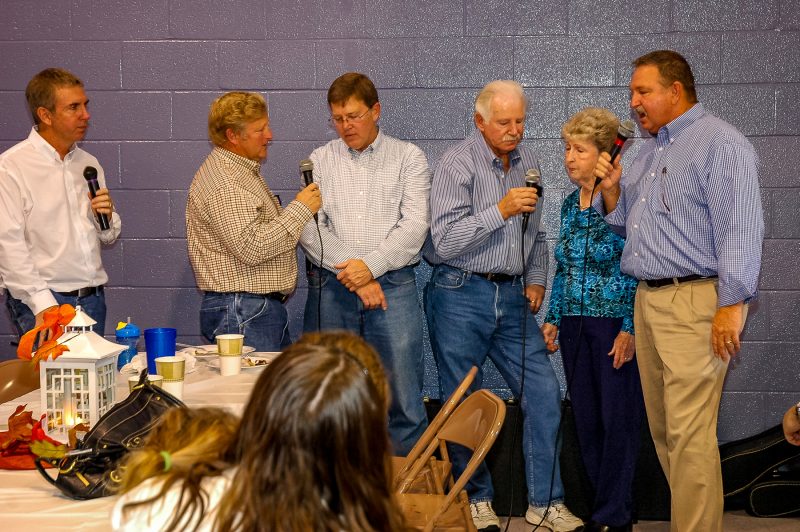
By the entrance there was a table of old photographs, including one of my maternal grandfather with his two brothers (essentially in the left-center of the picture below).

I never met him as he passed away long, long before I was born. I honestly don’t even know very well what he looked like, but Nana informed me that there was an uncle who looked very similar.

Everyone hovered around the picture table, though. They were the only record of many like my grandfather: people who would have loved to have seen how a small family grew into a small army company’s worth of people.
Seeing I had a fair amount of camera equipment (and associating equipment with skill, I suppose), a gentleman approached me to take some pictures of old faded images that he’d like to have copies of.

Of all the pictures snapped Saturday afternoon, these are worth more than all of those combined. These are the ones that somehow truly fulfill the role photographs are supposed to play in people’s lives.

A look at a time so far removed from ours that it might as well be a different world. And truly, it was a different world. Without the instant, worldwide communication, the pre-Twitter, pre-YouTube word was more insular.
Safer? I don’t know. After all, the Cuban Missile Crisis showed how a little Twitter can go a long way — or at least a direct line of communication between mutually powerful countries.
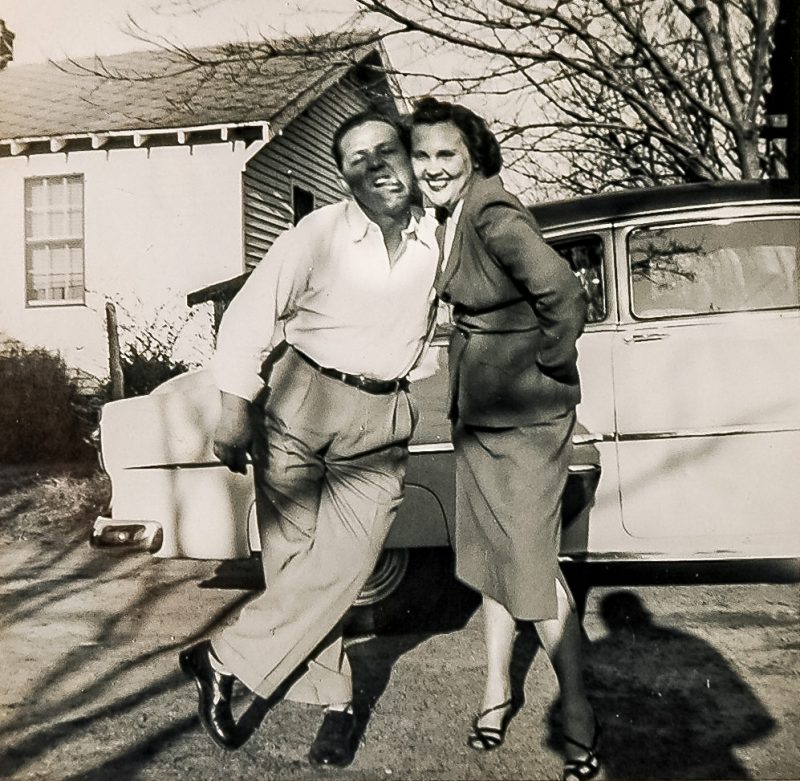
Bottom line, there was less — of everything. Somehow, that seems comforting.
Looking at these pictures, I regret I didn’t take the whole bunch out to the parking lot, lie them on the ground, and very carefully photograph them. After all, the pictures become fewer and fewer, as if somehow trying to pay tribute to the frugality of the times they capture.



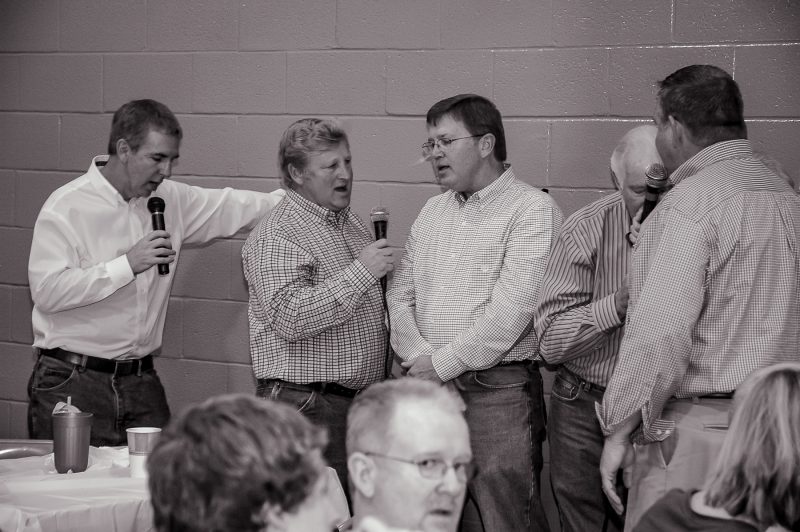





Authorized Biographies

If you’re the leader of a sect that believes in one-man (very much “man”), top-down leadership, how do you get your biography written?
Simple: you tell your staff to do it.
David C. Pack has held a variety of leadership roles throughout his dynamic, event-filled life: author of more than 20 books, scores of booklets and a vast array of articles–Pastor General of The Restored Church of God–voice of The World to Come program–founder of Ambassador Training Center–publisher/editor-in-chief of three magazines. The Authorized Biography of David C. Pack tells the life story of a man who was carefully prepared by God for a unique position. (RCG)
We can read the details of the life of David Pack, the Restored Church of God’s Pastor General, in painful detail: Volume One is a whopping 615 pages to cover 1948 through 1995! Volume Two is an additional 608 pages. It’s tempting to ask, “What did you leave out, Dave?”
He seems to have anticipated this:
Since an unusually wide range of experiences has enriched my life, a certain problem was created for the writers: which stories and encounters should be included in the biography. Of course, there were certain ones that had to be incorporated because of their transcending influence or impact on my life. The biography would fail in purpose if it did not contain them, coupled with an explanation of why they were important. This alone meant a lot of material needed to be included.
There was also a desire to relate stories that are of lesser importance, but that have had a role in shaping me nonetheless. It is not the biography’s purpose to make every one of these seem overly important or to present them as in every case having brought dramatic transformations in my thinking. Of course, some did. Both I and the many writers who participated struggled with how many, and which, stories to include, as well as when to cut off stories with the overall length of the biography in mind!
It was not the goal to bring in every story in my life, or every experience I have had. But, we believe that every one chosen adds to the overall picture of what shaped me, and it is my hope that the reader benefits and is left motivated, better informed and even inspired for having read them.
I can’t imagine pretending to be humble and appearing to all others to be exactly the opposite. Of course, if I thought I was, literally, the most significant person on the Earth, I might include the details about the time I sneezed and panicked at not having a tissue, or the time I thought I might ask a girl out but then wondered whether she would reject me.
Time
Is it cheating to post at 12:16am and count it as the previous day’s post? After all, for my consciousness, it’s the same day.
When I kept a journal religiously, I often fretted about this. “What date should I put on this?” Perhaps “fret” is the wrong word. Or maybe it is: when I was in Poland the first time (96-99), I wrote daily. One entry was along the lines of “I’m just writing this to keep my string of entries going.”
I guess this is something similar…
Stage Fright
Ron sits in the front row and raps. Sometimes it’s an audible mumble, but it’s often just a whisper.
Harvey likes to turn his desk into a drum set. He’ll beat, thump, scratch — he’ll get more sound out of a school desk than one would think possible.
Keeping them quiet is a recurring task. It’s not a constant battle, but I do have to ask them a few times a week to stop the disruption.
Working on poetry and teaching meter, I was having students gradually move from dryly reciting the poem (“Cat!”, from yesterday) to rapping it. The idea was to get them to create a rap and “a beat” and point out that it all depends on the pattern of stressed syllables in the poem. I asked Ron to rap; with a nervous laugh, he eventually begged off. When a student finally volunteered, I turned to Harvey to supply the beat. He too said he’d rather not.
Another ironic moment in the classroom.
Choral Cats

Photo by Hannibal Poenaru
We’ve started a poetry unit; as I always do, I began by asking students to do some free writing to answer a simple question: “What is poetry?” Inevitably, the first or second response mentions “feelings.” If I’m lucky — as I was today — they make broader connections, such as “music” or “enlightenment.”
Teaching poetry to adolescents is a trick. Boys don’t like it because, at this age, “feelings” are not something they generally care to delve into. Poetry has to seem alive and less academic. Today I rediscovered that a poem that is strongly rhythmic and filled with fun sound devices (onomatopoeia, alliteration, a bit of assonance) combined with some choral reading makes for a great start to a poetry unit.
“Cat!” by Eleanor Farjeon fit the bill perfectly.
Cat!
Scat!
After her, after her,
Sleeky flatterer,
Spitfire chatterer,
Scatter her, scatter her
Off her mat!
Wuff!
Wuff!
Treat her rough!
Git her, git her,
Whiskery spitter!
Catch her, catch her,
Green-eyed scratcher!
Slathery
Slithery
Hisser,
Don’t miss her!
Run till you’re dithery,
Hithery
Thithery
Pftts! pftts!
How she spits!
Spitch! Spatch!
Can’t she scratch!
Scritching the bark
Of the sycamore tree,
She’s reached her ark
And’s hissing at me
Pftts! pftts!
Wuff! wuff!
Scat,
Cat!
That’s
That!
Starting with an animated reading, we moved to a semi-choral reading, with students reading the italicized portions. Then a few students took a try at reading this verbally challenging poem. By then, it was easy slide into a discussion of onomatopoeia and verbal rhythm.
A successful lesson that leaves me eager to return tomorrow.
Photo by Hannibal Poenaru
Scat Cat
It’s still a cliche love-hate relationship: L still loves, the cat still hates. Or perhaps “the cat fears” would be more accurate.
In my pre-parenthood thoughts of what fatherhood would be like, I never realized that literally everything must be taught — even how to show love. It’s a given when we look at the dysfunctional relationships that are everywhere (most commonly on the covers of magazines in the checkout line). Still, I thought that if we taught by example, L would learn how to express affection.
We teach by example; we illustrate by experience (“See? We’re gentle with the cat and she comes to us.”); we instruct directly (“Hitting the cat is not a good way to show affection.”). Sometimes it works. Generally, Bida continues to head the other way whenever L enters the room.
Guard Duty
Alligator is after L. She tells me that he starts lurking about around bath time. When we’re getting her out of the bath, Alligator starts looking for her in earnest. I tell him he should look in the backyard. It buys us a little time. We get the Girl dressed, brush her teeth, and to her room, but by then, L is worried. It doesn’t take that long to search the backyard, and Alligator might come back any moment.

Fortunately, Crocodile is available to stand watch.



